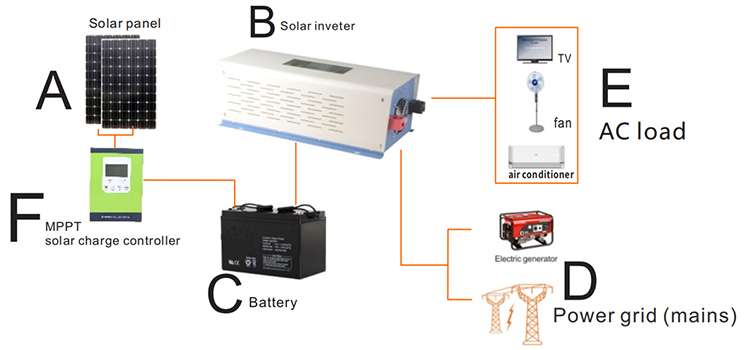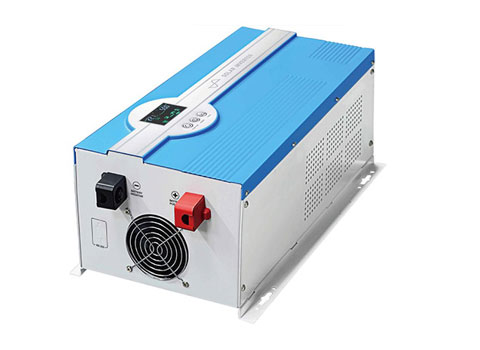In the context of the growing energy crisis and increasing environmental pressures, off-grid solar systems are gaining significant attention as a clean and sustainable energy solution. These systems are particularly crucial in remote areas, disaster emergencies, and regions with frequent power outages. However, their installation and operation are more complex and costly compared to grid-tied systems. Inverter.com will delve into how to simplify off-grid solar systems and reduce costs to meet the increasing market demand.
Optimization of system integration
Off-grid solar systems typically consist of key components such as solar panels, charge controllers, batteries, and inverters. To simplify the system, suppliers and manufacturers can reduce the number of components through integrated design while enhancing system performance. For instance, the introduction of "all-in-one" products that integrate solar panels, charge controllers, and inverters can significantly streamline installation steps, reduce installation difficulty, and save users time and costs. An off-grid solar package, which includes all necessary components in a pre-assembled kit, aims to simplify the installation and use of off-grid solar systems. These kits usually include solar panels, inverters, batteries, charge controllers, and related accessories. The advantages of choosing an off-grid solar package are as follows:
- Simplified Selection Process: For users without much technical background, selecting individual components and ensuring their compatibility can be complex. An off-grid solar package provides a complete solution, eliminating this concern for users.
- Reduced Installation Difficulty: Off-grid solar packages are typically designed for easy installation, enabling even users without professional experience to complete the installation following the manual, thereby reducing installation costs.
- Ensured System Compatibility: Pre-assembled kits guarantee compatibility among components, preventing system failures caused by incompatibility issues.
- Enhanced After-Sales Service: Users who purchase a complete system usually receive more comprehensive after-sales service. If the system encounters any problems, they can be quickly resolved.
When choosing an off-grid solar package, users should consider the following factors:
- System Capacity: Select an appropriate system capacity based on your electricity needs. Generally, household users can opt for systems ranging from 5kW to 10kW, while small commercial users may require larger capacities.
- Brand Reputation: Choosing products from well-known brands ensures system quality and stability and also provides better after-sales service.
- Component Quality: Ensure the quality of solar panels, inverters, and batteries. High-quality components not only improve system efficiency but also extend the system’s lifespan.

Selecting high-performance components
- High-Efficiency Solar Panels. Choose solar panels with high conversion efficiency and good durability to generate more electricity within the same area, thereby reducing maintenance costs in the long run.
- Smart Charge Controllers. Use advanced charge control algorithms to intelligently manage the charging and discharging processes of batteries, avoiding issues like overcharging and over-discharging, and extending battery lifespan.
- High-Efficiency Inverters. Select off-grid inverters with high efficiency, low losses, and high reliability to enhance the overall efficiency of the system and reduce energy loss. Additionally, inverters with various protection features (such as overload, short circuit, and overheat protection) ensure the safe and stable operation of the system.
Flexibility in system design
To meet the diverse needs and application scenarios of different users, off-grid solar systems need to offer a certain degree of design flexibility.
- Modular Design: Adopt a modular design approach, dividing the system into multiple independent modules, allowing users to combine and expand the system based on their actual needs. For example, users can gradually increase the capacity of solar panels and batteries as their electricity demand grows.
- Stackable Inverters: Support the stacking function of inverters, permitting users to expand the system capacity by increasing the number of inverters. This design not only facilitates expansion and upgrades but also reduces initial investment costs.
- Multiple Interfaces and Communication Protocols: Support various interfaces and communication protocols (such as RS485, RS232, Modbus, etc.), enabling users to exchange data and perform remote control with system monitoring software, smart meters, and other devices.
Simplifying installation and maintenance processes
- Provide Detailed Installation Guides and Video Tutorials. Suppliers should offer detailed installation guides and video tutorials to help users quickly master installation techniques and methods. Additionally, establish online support platforms or forums to facilitate user communication and consultation.
- Offer Comprehensive After-Sales Service. Suppliers should provide a comprehensive after-sales service system, including troubleshooting, repair and replacement, and technical support for products such as the 8kW pure sine wave off-grid solar inverter in Home Power Inverter. Especially in remote areas, a quick response mechanism should be established to ensure users receive timely help and support.
- Remote Monitoring System. Utilize a remote monitoring system to monitor the system's operational status and performance data in real-time, promptly identifying and resolving issues. Furthermore, the remote monitoring system can offer data analysis functions, helping users better understand system performance and usage conditions.

Cost reduction strategies
- Optimize Supply Chain: Lower procurement costs for raw materials and components by optimizing supply chain management. Establish long-term, stable partnerships to ensure suppliers provide high-quality products and services.
- Technological Innovation: Continuously invest in research and development to drive technological innovation and product upgrades. Enhance system efficiency and reliability through technological advancements, thereby reducing system costs.
- Customized Services: Provide tailored products and services based on users' specific needs and application scenarios. Meet users' unique requirements through customized services, thereby increasing user satisfaction and loyalty.
In summary, by optimizing system integration, selecting high-performance components, designing flexible system structures, simplifying installation and maintenance processes, and implementing cost-reduction strategies, off-grid solar systems can be made simpler and more cost-effective. At the same time, governments and relevant authorities should introduce supportive policies and incentives to promote the widespread adoption and application of off-grid solar systems, making a greater contribution to environmental protection and sustainable development.
